
Argonne National Laboratory is a federally funded research and development center in Lemont, Illinois, United States. Founded in 1946, the laboratory is owned by the United States Department of Energy and administered by UChicago Argonne LLC of the University of Chicago. The facility is the largest national laboratory in the Midwest.
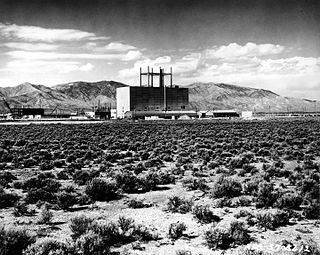
The Naval Reactors Facility (NRF) is located 52 miles (84 km) northwest of Idaho Falls, Idaho. The NRF is a United States Department of Energy-Naval Reactors facility where three nuclear propulsion prototypes A1W, S1W and S5G were located. It is contractor-operated for the government by Fluor Corporation through their subsidiary, Fluor Marine Propulsion, LLC, which also operates Bettis Atomic Power Laboratory and Knolls Atomic Power Laboratory.
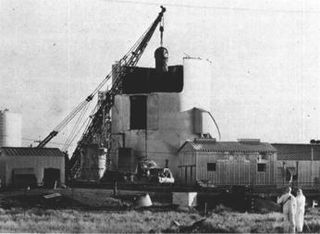
Stationary Low-Power Reactor Number One, also known as SL-1, initially the Argonne Low Power Reactor (ALPR), was a United States Army experimental nuclear reactor in the western United States at the National Reactor Testing Station (NRTS) in Idaho about forty miles (65 km) west of Idaho Falls, now the Idaho National Laboratory. On January 3, 1961, at 9:01 pm MST, an operator fully pulled out the reactor's central control rod, causing the reactor to go from fully shutdown to prompt critical. The intense heat from the nuclear reaction expanded the water inside the reactor core, producing extreme water hammer and causing water, steam, reactor components, debris, and fuel to vent from the top of the reactor where the three operators were working. As the water struck the top of the reactor vessel, it propelled the entire reactor vessel to the ceiling of the reactor room where it struck the overhead crane. A supervisor who had been on top of the reactor lid was impaled by an expelled control rod shield plug and pinned to the ceiling. The release of materials hit the two other operators, mortally injuring them. The reactor vessel then fell down to its original position.
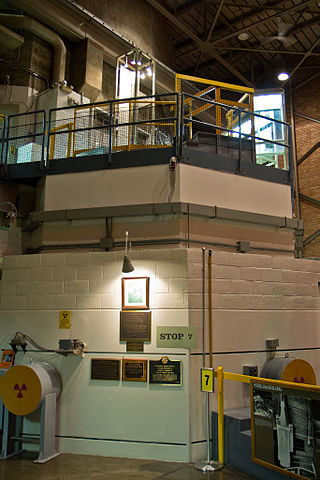
Experimental Breeder Reactor I (EBR-I) is a decommissioned research reactor and U.S. National Historic Landmark located in the desert about 18 miles (29 km) southeast of Arco, Idaho. It was the world's first breeder reactor. At 1:50 p.m. on December 20, 1951, it became one of the world's first electricity-generating nuclear power plants when it produced sufficient electricity to illuminate four 200-watt light bulbs. EBR-I subsequently generated sufficient electricity to power its building, and continued to be used for experimental purposes until it was decommissioned in 1964. The museum is open for visitors from late May until early September.

Idaho National Laboratory (INL) is one of the national laboratories of the United States Department of Energy and is managed by the Battelle Energy Alliance. Historically, the lab has been involved with nuclear research, although the laboratory does other research as well. Much of current knowledge about how nuclear reactors behave and misbehave was discovered at what is now Idaho National Laboratory. John Grossenbacher, former INL director, said, "The history of nuclear energy for peaceful application has principally been written in Idaho".
Passive nuclear safety is a design approach for safety features, implemented in a nuclear reactor, that does not require any active intervention on the part of the operator or electrical/electronic feedback in order to bring the reactor to a safe shutdown state, in the event of a particular type of emergency. Such design features tend to rely on the engineering of components such that their predicted behaviour would slow down, rather than accelerate the deterioration of the reactor state; they typically take advantage of natural forces or phenomena such as gravity, buoyancy, pressure differences, conduction or natural heat convection to accomplish safety functions without requiring an active power source. Many older common reactor designs use passive safety systems to a limited extent, rather, relying on active safety systems such as diesel-powered motors. Some newer reactor designs feature more passive systems; the motivation being that they are highly reliable and reduce the cost associated with the installation and maintenance of systems that would otherwise require multiple trains of equipment and redundant safety class power supplies in order to achieve the same level of reliability. However, weak driving forces that power many passive safety features can pose significant challenges to effectiveness of a passive system, particularly in the short term following an accident.
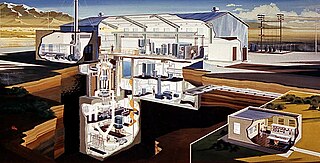
The BORAX Experiments were a series of safety experiments on boiling water nuclear reactors conducted by Argonne National Laboratory in the 1950s and 1960s at the National Reactor Testing Station in eastern Idaho. They were performed using the five BORAX reactors that were designed and built by Argonne. BORAX-III was the first nuclear reactor to supply electrical power to the grid in the United States in 1955.
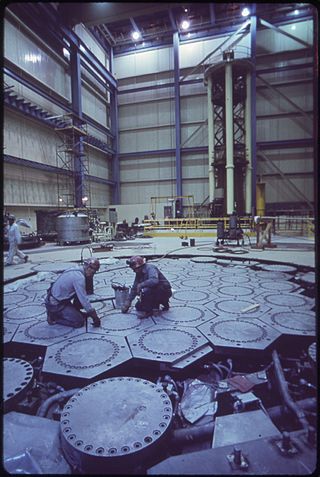
A high-temperature gas-cooled reactor (HTGR) is a type of gas-cooled nuclear reactor which use uranium fuel and graphite moderation to produce very high reactor core output temperatures. All existing HTGR reactors use helium coolant. The reactor core can be either a "prismatic block" or a "pebble-bed" core. China Huaneng Group currently operates HTR-PM, a 250 MW HTGR power plant in Shandong province, China.
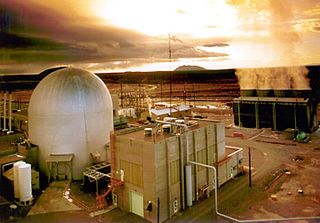
Experimental Breeder Reactor-II (EBR-II) was a sodium-cooled fast reactor designed, built and operated by Argonne National Laboratory at the National Reactor Testing Station in Idaho. It was shut down in 1994. Custody of the reactor was transferred to Idaho National Laboratory after its founding in 2005.

The Advanced Test Reactor (ATR) is a research reactor at the Idaho National Laboratory, located east of Arco, Idaho. This reactor was designed and is used to test nuclear fuels and materials to be used in power plants, naval propulsion, research and advanced reactors. It can operate at a maximum thermal power of 250 MW and has a "Four Leaf Clover" core design that allows for a variety of testing locations. The unique design allows for different neutron flux conditions in various locations. Six of the test locations allow an experiment to be isolated from the primary cooling system, providing its own environment for temperature, pressure, flow and chemistry, replicating the physical environment while accelerating the nuclear conditions.

The Zero Power Physics Reactor or ZPPR was a split-table-type critical facility located at the Idaho National Laboratory, Idaho, USA. It was designed for the study of the physics of power breeder systems and was capable of simulating fast reactor core compositions characteristic of 300-500 MWe demonstration plants and 1000 MWe commercial plants.

The Office of Nuclear Energy (NE) is an agency of the United States Department of Energy which promotes nuclear power as a resource capable of meeting the energy, environmental, and national security needs of the United States by resolving technical and regulatory barriers through research, development, and demonstration.

The Materials Testing Reactor (MTR) was an early nuclear reactor specifically designed to facilitate the conception and the design of future reactors. It produced much of the foundational irradiation data that underlies the nuclear power industry. It operated in Idaho at the National Reactor Testing Station from 1952 to 1970.

The Transient Reactor Test Facility (TREAT) is an air-cooled, graphite moderated, thermal spectrum test nuclear reactor designed to test reactor fuels and structural materials. Constructed in 1958, and operated from 1959 until 1994, TREAT was built to conduct transient reactor tests where the test material is subjected to neutron pulses that can simulate conditions ranging from mild transients to reactor accidents. TREAT was designed by Argonne National Laboratory, and is located at the Idaho National Laboratory. Since original construction, the facility had additions or systems upgrades in 1963, 1972, 1982, and 1988. The 1988 addition was extensive, and included upgrades of most of the instrumentation and control systems.
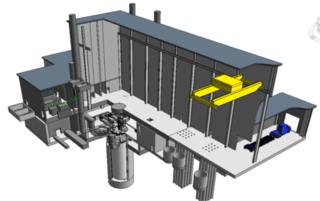
The Versatile Test Reactor (VTR) was a project by the U.S. Department of Energy to build a fast-neutron test reactor by 2026. Funding for the project was scrapped in 2022
The Aurora powerhouse is an advanced fission plant concept design that received a site use permit for testing in 2020 from the United States Department of Energy (DOE). The site use permit, issued in December 2019 is not a Nuclear Regulatory Commission permit. It is the "first and only permit ever issued in the U.S. to a nuclear plant using something other than a light water ("water-cooled") reactor". It will use "recycled" high-assay, low-enriched uranium (HALEU) fuel originally fabricated for the Experimental Breeder Reactor II (EBR-II), and if fully operational, would become "the first fuel-recycling commercial reactor in the United States". The DOE's Idaho National Laboratory (INL) said it would provide 10 tons of HALEU for the test reactor which corresponds to most of the available supply. Reprocessing would occur at INL's Materials and Fuels Complex (MFC) and possibly also the Idaho Nuclear Technology and Engineering Center (INTEC), neither of which are operational facilities as of early 2020.
Argonne Fast Source Reactor (AFSR) was a research reactor which was located at the Argonne National Laboratory, a United States Department of Energy national laboratory, facility located in the high desert of southeastern Idaho between Idaho Falls, Idaho and Arco, Idaho.
Advanced Reactivity Measurement Facility I (ARMF-I) was a research reactor which was located at the Argonne National Laboratory, a United States Department of Energy national laboratory, facility located in the high desert of southeastern Idaho between Idaho Falls, Idaho and Arco, Idaho. ARMF-I was nearly identical to ARMF-II.













